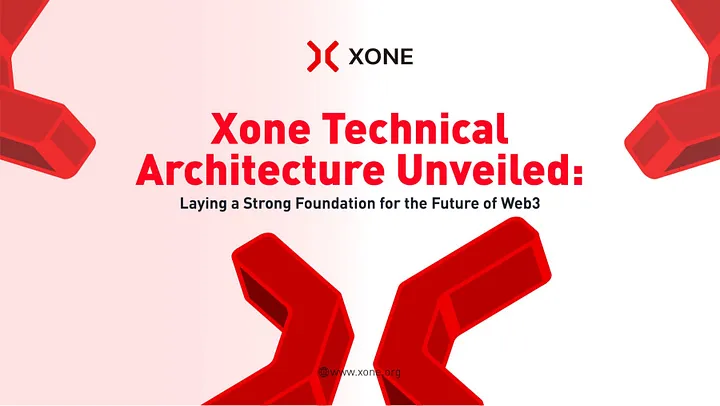Xone Technical Architecture Unveiled —— Laying a Strong Foundation for the Future of Web3

The landscape of blockchain technology is evolving at a rapid pace, and Xone is at the forefront of this revolution. By combining EVM compatibility with a modular architecture, Xone is not just another public chain; it’s a comprehensive ecosystem designed to drive the growth and adoption of Web3 technologies. This technical innovation serves as the cornerstone of Xone’s vision for a decentralized future. Let’s dive into the key elements of Xone’s technical architecture and how they enable scalable, efficient, and cost-effective blockchain solutions.
1️⃣ Modular Architecture for Flexibility and Scalability
Xone’s modular design is one of its most innovative features. By integrating the Cosmos SDK and IBC (Inter-Blockchain Communication Protocol), Xone ensures that cross-chain interoperability is at the core of its ecosystem. This design allows Xone to support a variety of use cases while providing:
-
Customizability: Developers can choose the right modules to fit their needs, enabling more efficient and tailored blockchain applications.
-
Scalability: Xone’s architecture supports applications across diverse sectors such as DeFi, GameFi, NFTs, and enterprise solutions, ensuring that the platform can grow as Web3 continues to evolve.
-
Cross-Chain Interoperability: With IBC, Xone enhances connectivity between different blockchain networks, making it easier for users to transfer assets and data across platforms seamlessly.
2️⃣ High-Performance Consensus Mechanism
Xone utilizes a Proof of Stake (PoS) consensus mechanism, which offers several advantages, particularly in terms of speed and cost-efficiency:
-
Fast Transactions: With a block generation time of just 1 second, Xone ensures quick transaction confirmation. This is crucial for high-speed applications such as DeFi, GameFi, and other sectors that require real-time processing.
-
Low Transaction Costs: Xone’s PoS consensus mechanism significantly reduces transaction fees compared to other public chains. This makes it easier for developers to build decentralized applications (dApps) and for users to interact with the ecosystem without incurring high fees.
The low-latency feature ensures a smooth and efficient user experience, making Xone highly suitable for high-participation scenarios like DeFi and GameFi, where speed and cost efficiency are paramount.
3️⃣ EVM Compatibility for Seamless Migration
Xone’s EVM compatibility is another standout feature. This allows developers to easily migrate Ethereum-based dApps to the Xone network. Here’s why this is important:
-
Seamless Migration: Developers already familiar with Ethereum can use the same tools, libraries, and wallets they use on Ethereum, significantly reducing entry barriers.
-
Frictionless Development: Xone allows Ethereum-based projects to leverage the platform’s high-performance PoS consensus, low fees, and interoperability, giving developers the flexibility to scale their applications and integrate with other blockchain ecosystems seamlessly.
This compatibility ensures that developers can harness the power of Xone’s infrastructure while maintaining the ease of building on Ethereum.
4️⃣ POBVI: A Revolutionary Incentive Model
Xone’s Proof of Behavior Value Incentive (POBVI) mechanism is one of the platform’s most transformative innovations. It rewards user engagement and contributions by converting every on-chain action into quantifiable rewards. This model fundamentally reshapes decentralized incentives in the blockchain space:
-
Engagement Incentives: POBVI ensures that users are continuously rewarded for participating in governance, staking, and contributing to the network.
-
Dynamic Ecosystem: By rewarding users based on the size of their contributions, POBVI drives more active participation and fosters a robust and dynamic ecosystem.
-
Transparency and Efficiency: The POBVI model makes the distribution of rewards more transparent and efficient, ensuring that value is distributed fairly and proportionally to all participants.
This mechanism addresses the long-term incentive problem seen in traditional blockchain projects, ensuring that participants stay committed to the network’s growth and sustainability.
5️⃣ Positioning for the Future of Web3
With Xone’s technical architecture, the platform is poised to meet the growing demands of the Web3 ecosystem. The combination of modular design, high-performance PoS consensus, EVM compatibility, and POBVI gives Xone a distinct advantage in powering the next generation of decentralized applications.
As blockchain adoption grows, Xone’s scalable infrastructure and innovative consensus mechanisms will support the increasing complexity and diversity of Web3 projects. The platform’s commitment to providing secure, cost-effective, and sustainable blockchain solutions positions it as a key player in the decentralized economy.
Conclusion: A Decentralized Future Built on Innovation
Xone is not just another public blockchain; it is a holistic ecosystem that brings together innovation, technology, and community. Through modular design, scalability, and a strong incentive model, Xone is helping to drive the next wave of blockchain adoption and decentralization.
With these technical advancements, Xone is ready to support the growing demands of Web3, providing developers and users with the tools they need to thrive in a decentralized world.
🌐 Learn more about Xone’s technical architecture: Xone Website